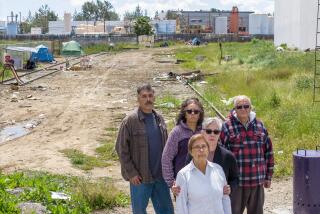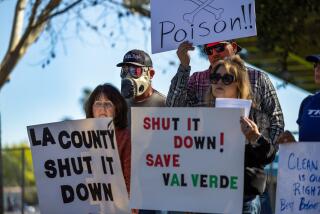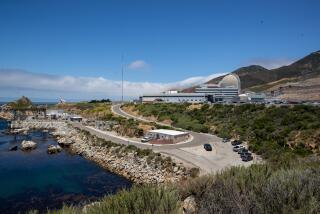Preliminary NRC report finds a host of ‘deficiencies’ after incident at San Onofre nuclear plant
The operator of the San Onofre nuclear power plant was faulted for multiple procedural and oversight deficiencies after problems were found involving the transfer of a 45-ton canister of spent nuclear fuel into a deep storage enclosure at the plant, according to preliminary findings from an inspection by the Nuclear Regulatory Commission.
The findings come after an incident in August in which the canister got stuck as it was being lowered into an underground storage cavity and was left suspended about 18 feet above the floor for 45 minutes to an hour, officials said. Transfers have since been placed on hold.
Southern California Edison, the plant’s operator, was faulted for a series of “deficiencies involving training, equipment, procedures, oversight and corrective actions” in connection with the incident, according to the NRC’s report. Edison was also cited for not reporting the incident sooner.
A team of three NRC inspectors spent a week at the plant last month conducting their review.
Tom Palmisano, vice president of decommissioning and chief nuclear operator at San Onofre, said, “generally, we agree and concur” with the preliminary findings and added they roughly track a “causal analysis” Edison is conducting about the incident.
“I think the important message is that this was an unacceptable situation that should not have occurred, we have taken actions to make sure it doesn’t occur [again] and we will not restart fuel handling until corrective actions are in place and until we are satisfied,” Palmisano said.
A final inspection report from the NRC is expected to be issued in about a month. Operators of the plant, which is holding 3.55 million pounds of nuclear waste, are in the midst of transferring 73 canisters of spent fuel from what is called wet storage — where nuclear fuel is cooled for about five years in a deep pool of water — to a newly constructed “dry storage” facility at the plant.
On Aug. 3, workers using rigging and lifting equipment attempted to lower a canister of spent fuel into the storage cavity. Crews thought they had maneuvered the canister into place. But instead, it had gotten hung up on a support ring inside the enclosure, almost 20 feet above the cavity’s floor.
An oversight team discovered the problem and the canister was safely lowered the rest of the way about an hour later.
Edison officials have insisted the incident posed no danger to workers or the general public, with Palmisano saying the “very robust design” of the canister would have prevented any radiological leak if it had suddenly dropped the 18 feet to the floor.
The incident came to light six days later, when a worker for a subcontractor at the plant spoke up at a meeting of San Onofre’s Community Engagement Panel and said the canister was “hanging by about a quarter inch.”
Palmisano described the incident as a “serious near-miss” and said canister transfers had been suspended until the problems is ironed out.
The NRC, which is in charge of protecting public health and safety related to nuclear energy across the country, said it “observed instances where personnel involved in important-to-safety tasks were not trained and certified or under direct supervision.”
Edison officials informed the NRC about the incident on the following business day — Aug. 6 — but the agency said plant operators should have reported it within 24 hours. The agency said San Onofre officials filed the necessary paperwork on Sept. 14 “following prompting by NRC staff.”
Palmisano said that since the canister did not fall, Edison officials did not think they needed to file a 24-hour report. The NRC “felt it did. Therefore, they’ve identified that as a potential issue.”
Palmisano said the NRC also concluded that plant operators should have learned a lesson from a similar incident in July, previously unreported, in which workers transferring a canister also encountered trouble lowering it into place, but it did not get stuck. The agency said the incident did not require notification of the NRC or the public
Dave Lochbaum, former director of the Nuclear Safety Project at the Union of Concerned Scientists and a former NRC employee, told the San Diego Union-Tribune it’s fairly common for the NRC to issue a preliminary report from an inspection at a site like San Onofre that attracts a high degree of public and media attention.
“It’s clear that Edison, Holtec and the NRC are taking this near-miss very seriously,” Lochbaum said. “If and when they resume transfers, it’s clear they’ve used up their ‘get out of jail free’ card and no more near-misses are going to be tolerated by the NRC. I think that’s good news for the community.”
Critics of Edison were not satisfied by the NRC’s initial findings. “If the regulators were doing their jobs, they would have ordered Edison to immediately cease operations” after the Aug. 3 incident, Charles Langley, the executive director of Public Watchdogs, said in an email.
“A real regulator would have had boots on the ground within hours of learning about an incident like this.”
Ray Lutz, national coordinator for the advocacy group Citizens Oversight, said failures in training and procedures raise other questions.
“If it is so easy to make a mistake, the design of the storage system should also be questioned,” Lutz said in an email. “Why is there a place where the canister can catch in the first place?”
So far, crews have transferred 29 canisters from wet storage to dry cask storage this year. Edison expects to transfer the remaining 44 canisters by the middle of next year.
Nikolewski writes for the San Diego Union-Tribune.
rob.nikolewski@sduniontribune.com
More to Read
Start your day right
Sign up for Essential California for news, features and recommendations from the L.A. Times and beyond in your inbox six days a week.
You may occasionally receive promotional content from the Los Angeles Times.






